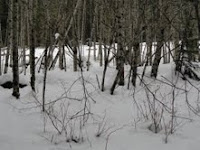 I needed my outdoor fix today so I rose at 5 a.m. and drove myself to Charles Lathrop Pack Experimental Forest in Eatonville. The idea of squeezing in seven miles before my work shift had me flying so high that it didn’t dawn on me until I’d parked at the trailhead that it was still pitch black outside and I couldn’t see more than a foot in front of me.
I needed my outdoor fix today so I rose at 5 a.m. and drove myself to Charles Lathrop Pack Experimental Forest in Eatonville. The idea of squeezing in seven miles before my work shift had me flying so high that it didn’t dawn on me until I’d parked at the trailhead that it was still pitch black outside and I couldn’t see more than a foot in front of me. Not to be deterred, I headed up Hugo Peak and tried not to wince as I felt my boots slip in the  never-ending mud puddles that plagued the narrow path. It was a treat to wake up with the forest. Since I couldn’t see much for the first mile or so, I honed my other senses and listened to a swift
never-ending mud puddles that plagued the narrow path. It was a treat to wake up with the forest. Since I couldn’t see much for the first mile or so, I honed my other senses and listened to a swift  breeze rustling the treetops and birds tweeting from nearby bushes. The real treat was hearing the thumb of pheasants in the darkness. Then the first glimmers of light streamed through the trees and I could see that I was surrounded by ferns and widely spaced trees.
breeze rustling the treetops and birds tweeting from nearby bushes. The real treat was hearing the thumb of pheasants in the darkness. Then the first glimmers of light streamed through the trees and I could see that I was surrounded by ferns and widely spaced trees.
The trail steadily climbed, crossing four different forest roads as it  wound its way through forest and a wide opening that allowed for a spectacular view of the surrounding peaks and valleys. It was a crisp, clear morning and I managed to stay just ahead of the rain.
wound its way through forest and a wide opening that allowed for a spectacular view of the surrounding peaks and valleys. It was a crisp, clear morning and I managed to stay just ahead of the rain.
 It took me about an hour to reach the “summit,” which was two log benches and a wooden box with a notebook to record your name and comment on the hike. I spent a few moments exploring the grass clearing I found myself in before jotting my name, date and the message “There is no better way to wake up than with the forest!” and starting my descent.
It took me about an hour to reach the “summit,” which was two log benches and a wooden box with a notebook to record your name and comment on the hike. I spent a few moments exploring the grass clearing I found myself in before jotting my name, date and the message “There is no better way to wake up than with the forest!” and starting my descent.
Since I had finished the seven miles far before I had anticipated, I opted to poke around the forestry campus, which houses the University of Washington’s Center for Sustainable Forestry on a 4,300-acre plot, before hightailing it to work.


























